In the enchanting landscapes of Minnesota, 11 owl species grace the skies, each contributing its unique charm to the state’s rich biodiversity.
From the iconic Great Horned Owl, known for its majestic presence, to the elusive Boreal Owl dwelling in northern forests, these avian wonders captivate both seasoned birdwatchers and casual observers.
This exploration delves into the diverse owl population, shedding light on their distinct characteristics, habitats, and the delicate balance they maintain within Minnesota’s ecosystems.
Join us on a journey through woodlands, grasslands, and open fields to discover the intricate lives of these nocturnal hunters, unraveling the secrets of their survival and the conservation efforts crucial to their continued existence in the North Star State. Stay sharp.
11 Owls in Minnesota
Find out the enchanting world of Minnesota’s owls, each with its unique characteristics and adaptations. From the majestic Great Horned Owl to the elusive Boreal Owl, delve into the lives of these captivating birds.
Discover their habitats, hunting techniques, and the conservation efforts dedicated to preserving these feathered wonders in the North Star State.
1. Great Horned Owl
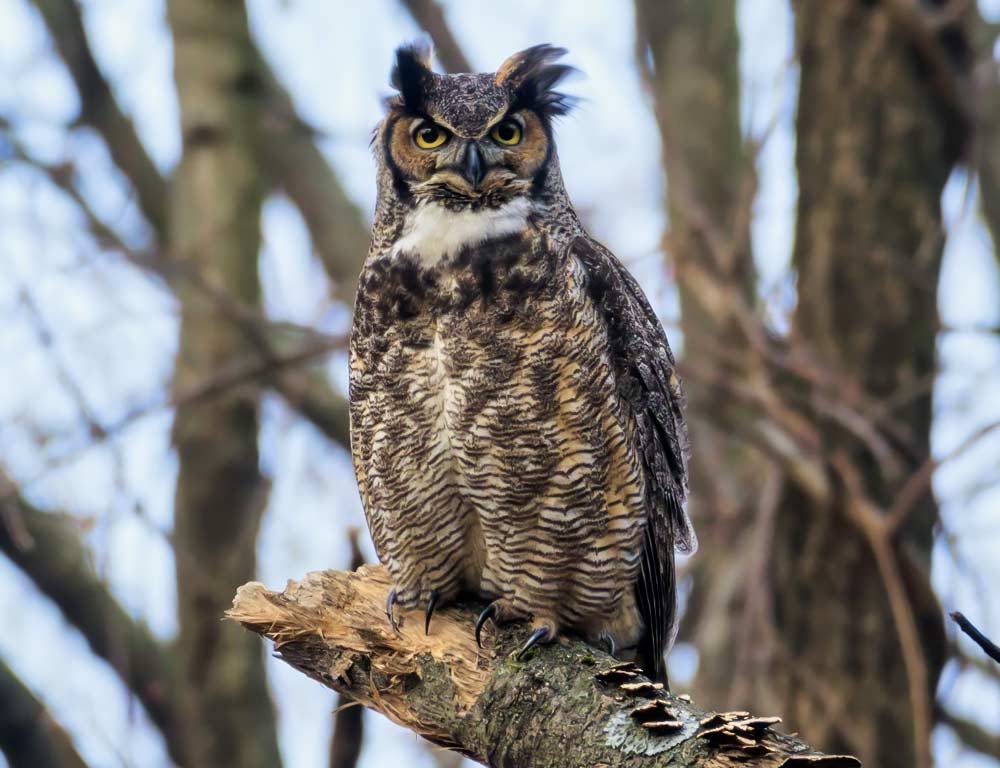
- Scientific Name: Bubo virginianus
- Population: Common throughout Minnesota
- Life Span: 5 to 15 years in the wild
- Size: 18-25 inches tall
- Weight: 2-5.5 pounds
- Wingspan: 3.3-4.8 feet
- Status: Secure
The Great Horned Owl, a powerful and adaptable bird of prey, is a year-round resident in Minnesota.
Renowned for its distinctive “horns,” which are actually tufts of feathers, this owl exhibits a diverse range of colors, including shades of brown, gray, and white.
It’s known for its exceptional hunting abilities, preying on various mammals, birds, and even larger prey like skunks or geese.
Great Horned Owls are skilled hunters, utilizing their keen vision and silent flight to capture prey.
Their breeding season begins in winter, and they often nest in abandoned nests of other large birds. The female typically lays two eggs, and the devoted parents fiercely protect their young.
2. Barn Owl
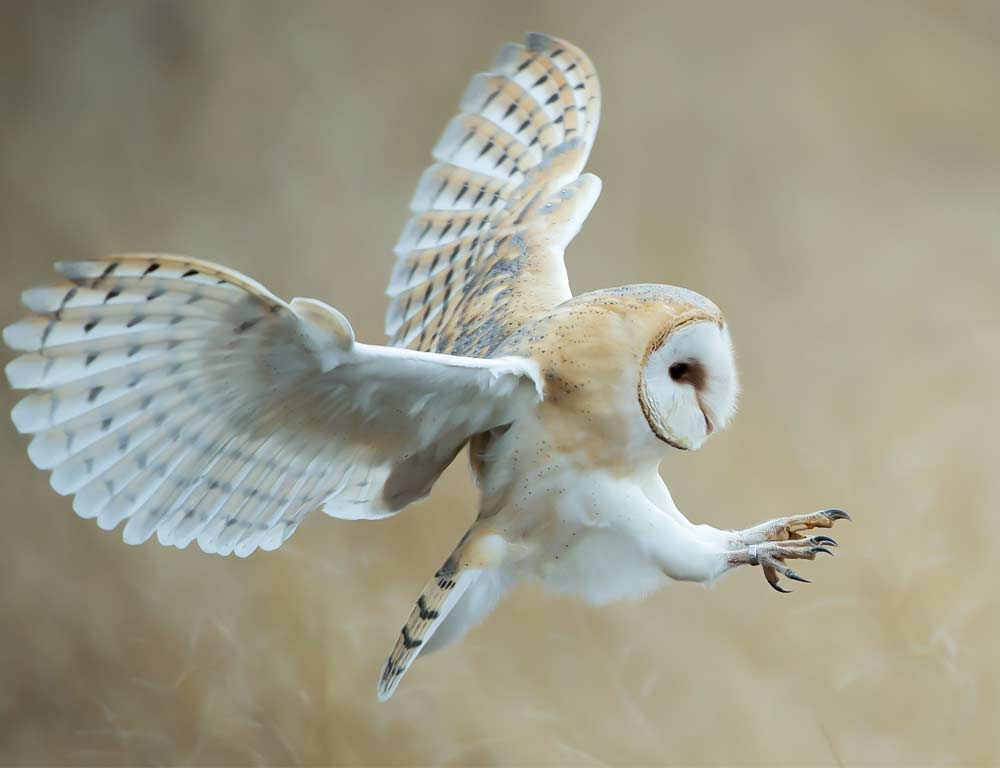
- Scientific Name: Tyto alba
- Population: Found throughout Minnesota, more concentrated in rural areas
- Life Span: 2-5 years in the wild
- Size: 12-15 inches tall
- Weight: 14-24 ounces
- Wingspan: 42-47 inches
- Status: Secure
The Barn Owl, with its distinctive heart-shaped facial disc, is common in Minnesota’s countryside. Recognized for its pale plumage, this nocturnal hunter primarily feeds on small mammals like mice and voles.
Barn Owls have specialized hearing, allowing them to locate prey in total darkness.
These owls prefer nesting in barns, abandoned buildings, or tree hollows. They usually lay a clutch of 4-7 eggs, and their reproductive success is tied to prey availability.
Barn Owls contribute to natural pest control by keeping rodent populations in check.
3. Snowy Owl
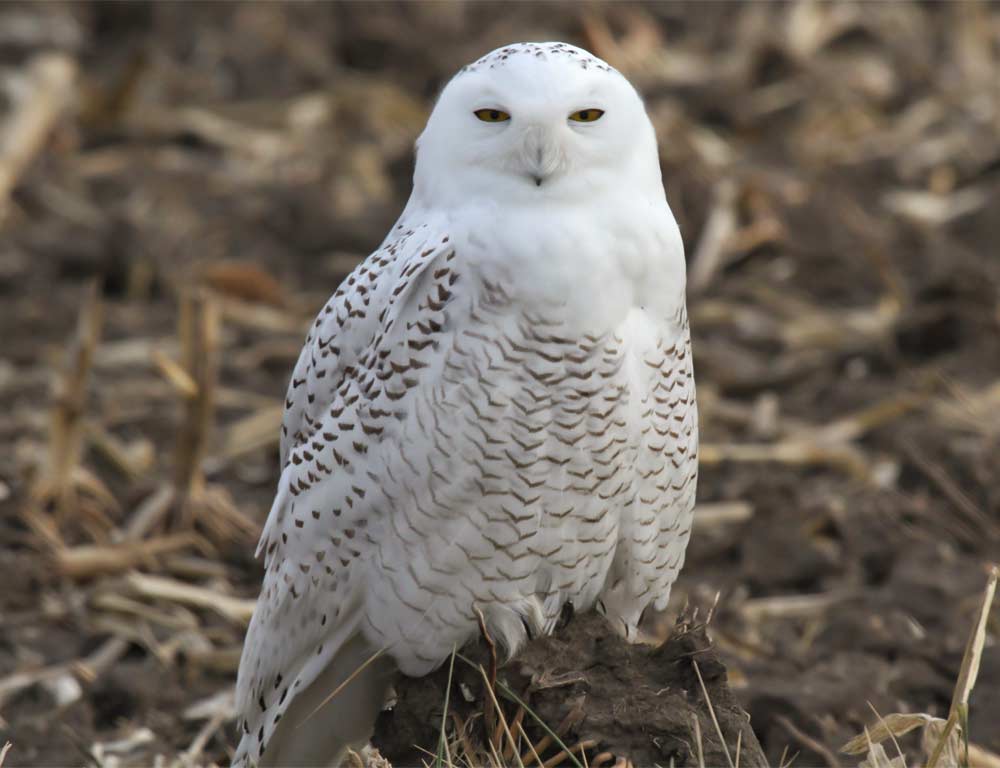
- Scientific Name: Bubo scandiacus
- Population: Seasonal visitor to Minnesota, more common during winter
- Life Span: 9-10 years in the wild
- Size: 20-28 inches tall
- Weight: 3-6.6 pounds
- Wingspan: 4.2-4.8 feet
- Status: Least Concern
The Snowy Owl, famous for its white plumage, is an enchanting visitor to Minnesota during winter.
Hailing from the Arctic, these owls migrate south in search of food. They are often spotted in open areas, including fields and shorelines.
Snowy Owls are well-adapted to the harsh Arctic conditions and are efficient hunters of lemmings and other small mammals. During winter, their diet may shift to include waterfowl and other birds.
Despite their striking appearance, these owls are well-camouflaged in snowy landscapes, making them skilled predators.
Conservation efforts are in place to monitor and protect their populations as they face threats from climate change and habitat disturbance.
4. Barred Owl
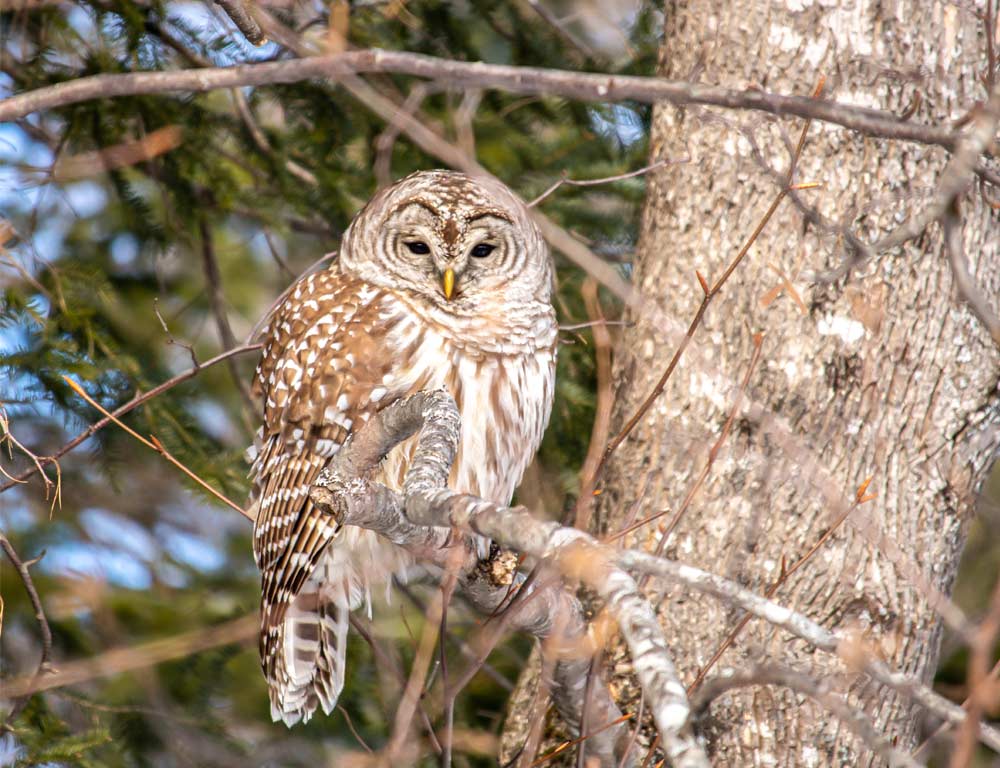
- Scientific Name: Strix varia
- Population: Common throughout Minnesota
- Life Span: 10-15 years in the wild
- Size: 16-24 inches tall
- Weight: 1-2.3 pounds
- Wingspan: 38-49 inches
- Status: Secure
The Barred Owl, a medium-sized owl with a distinctive hooting call, is a permanent resident of Minnesota’s woodlands.
Identified by its brown plumage and barred chest, these owls are adaptable hunters, preying on small mammals, birds, and amphibians.
Barred Owls are known for their territorial behavior and can often be heard calling to each other in the evenings.
They are cavity nesters, utilizing old tree nests or snags for breeding. Their courtship involves vocal duets between mates. Barred Owls play a crucial role in controlling rodent populations in their habitats.
5. Eastern Screech Owl
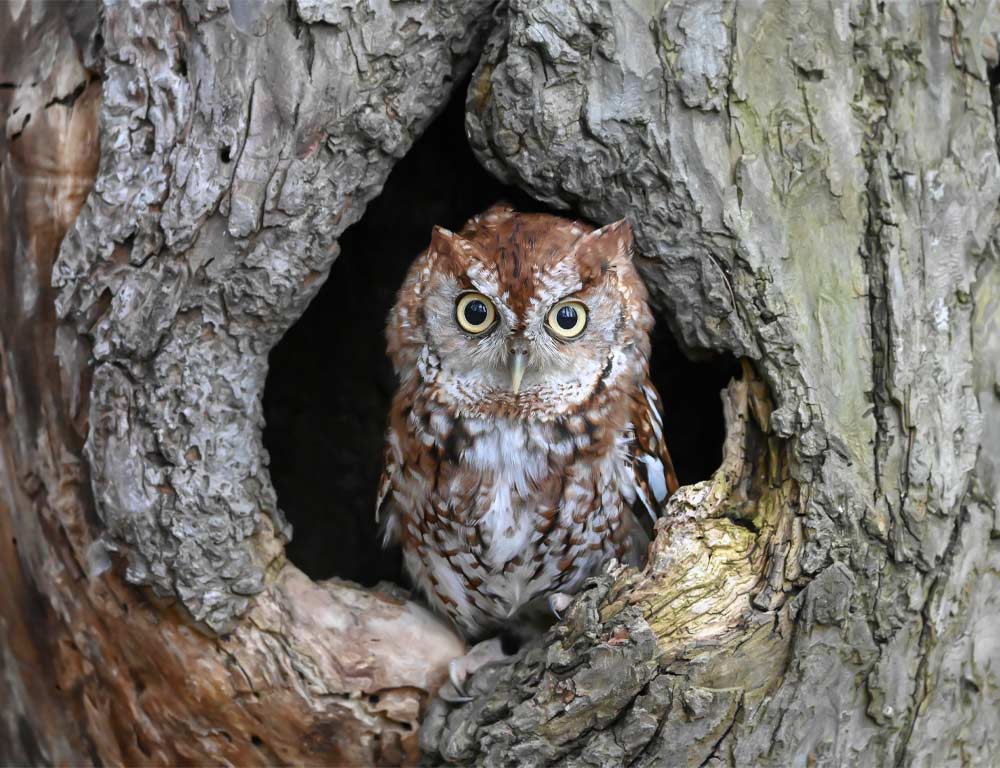
- Scientific Name: Megascops asio
- Population: Common, particularly in wooded areas
- Life Span: 3-7 years in the wild
- Size: 6-10 inches tall
- Weight: 4-8 ounces
- Wingspan: 18-24 inches
- Status: Secure
The Eastern Screech Owl, found in various color morphs, including gray and reddish-brown, is a small but widespread owl in Minnesota. Despite its name, it doesn’t always screech but may produce whinnies or soft trills.
They are adaptable hunters, feeding on insects, small mammals, and birds. Eastern Screech Owls are cavity nesters, utilizing tree hollows or nest boxes.
They are well-camouflaged and use their keen senses to detect prey in low-light conditions. These owls are particularly active during twilight, making them more challenging to spot.
6. Great Grey Owl
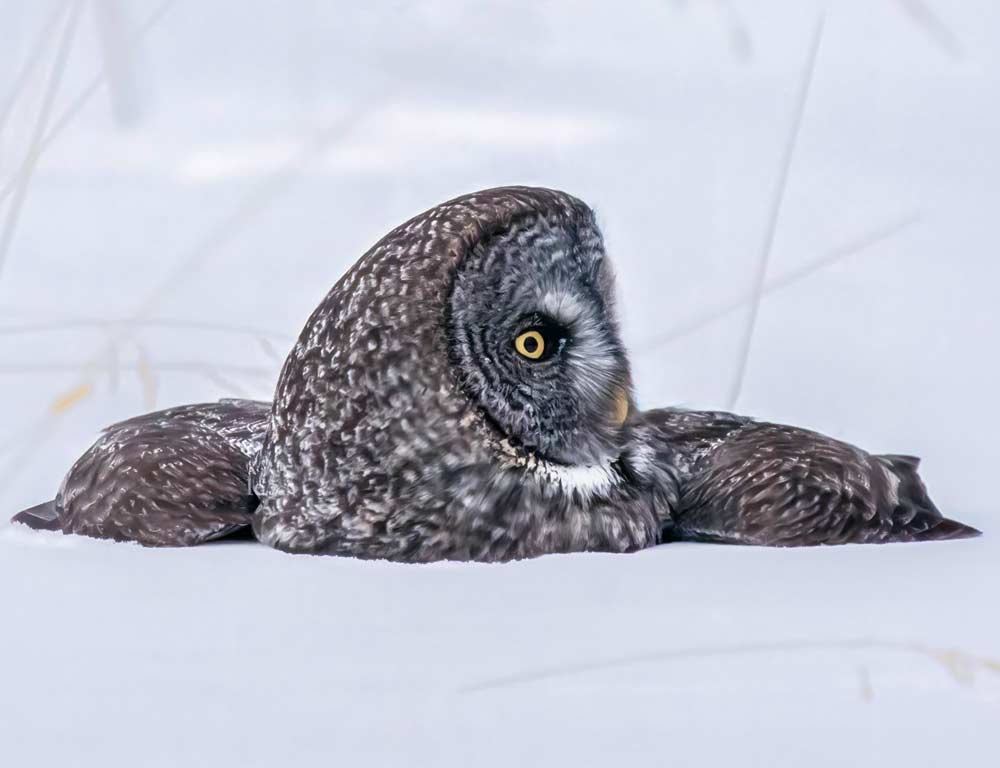
- Scientific Name: Strix nebulosa
- Population: Irregular visitors, more common during irruption years
- Life Span: 4-10 years in the wild
- Size: 24-33 inches tall
- Weight: 1.5-5 pounds
- Wingspan: 53-60 inches
- Status: Least Concern
With its large size and facial disk, the Great Grey Owl is an occasional visitor to Minnesota, especially during irruption years when they migrate south in search of food.
These majestic owls primarily hunt small mammals like voles and mice. Known as the “Phantom of the North,” the Great Grey Owl’s plumage blends with the tree bark, providing excellent camouflage.
They are known for their silent flight and acute hearing, allowing them to locate prey beneath the snow.
Conservation efforts aim to protect their habitats during irruption years to ensure their regional well-being.
7. Long-eared Owl
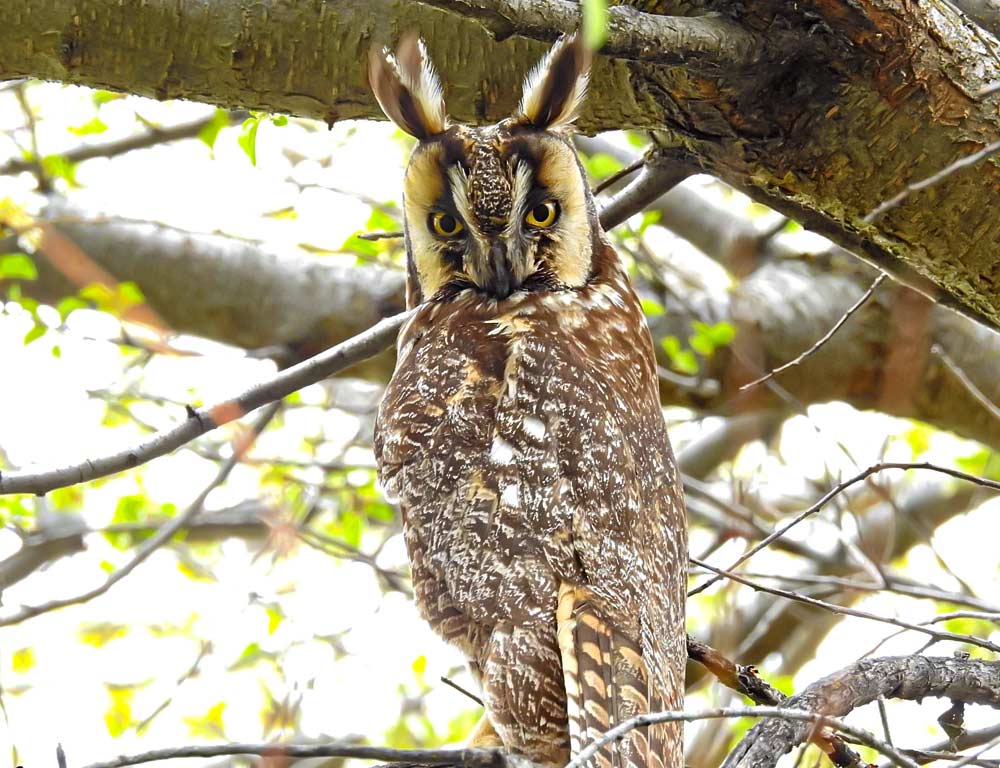
- Scientific Name: Asio otus
- Population: Found in suitable habitats, not uncommon
- Life Span: 4-5 years in the wild
- Size: 13-16 inches tall
- Weight: 7-15 ounces
- Wingspan: 35-39 inches
- Status: Secure
The Long-eared Owl, named for its long ear tufts rather than actual ears, is a medium-sized owl found in various habitats, including woodlands and open areas in Minnesota.
These owls are known for their cryptic plumage, blending well with tree bark. Long-eared Owls primarily hunt small mammals, birds, and insects.
Despite their somewhat secretive nature, Long-eared Owls may gather in communal roosts during the non-breeding season.
They are agile fliers, and their elongated ear tufts contribute to their distinctive appearance. Conservation efforts focus on protecting their roosting and breeding habitats.
8. Northern Saw-whet Owl
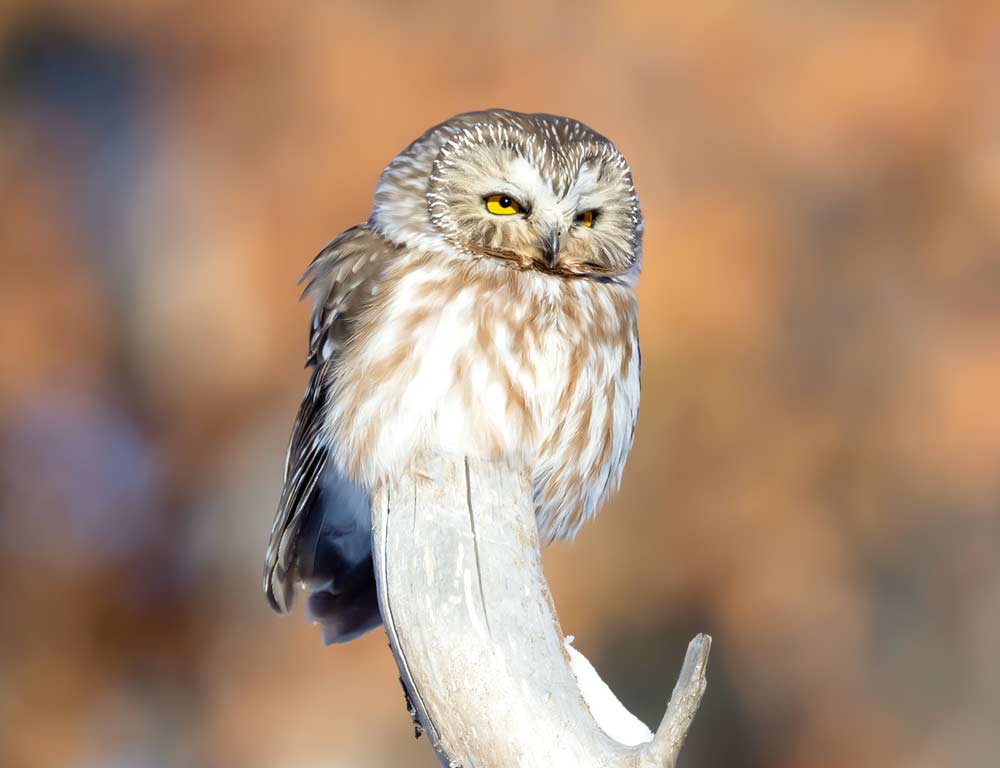
- Scientific Name: Aegolius acadicus
- Population: Common, especially in coniferous forests
- Life Span: 3-7 years in the wild
- Size: 7-8 inches tall
- Weight: 2-5 ounces
- Wingspan: 16-18 inches
- Status: Secure
The Northern Saw-whet Owl, a small and compact owl with a distinctive “toot-toot-toot” call resembling a saw being sharpened, is a common resident in Minnesota.
These nocturnal hunters feed on small mammals, including mice and voles. Northern Saw-whet Owls nest in tree cavities and may use abandoned nests of other birds.
They are highly migratory, with some individuals traveling long distances during the winter. Conservation efforts include monitoring their migration patterns and protecting key habitats.
9. Short-eared Owl
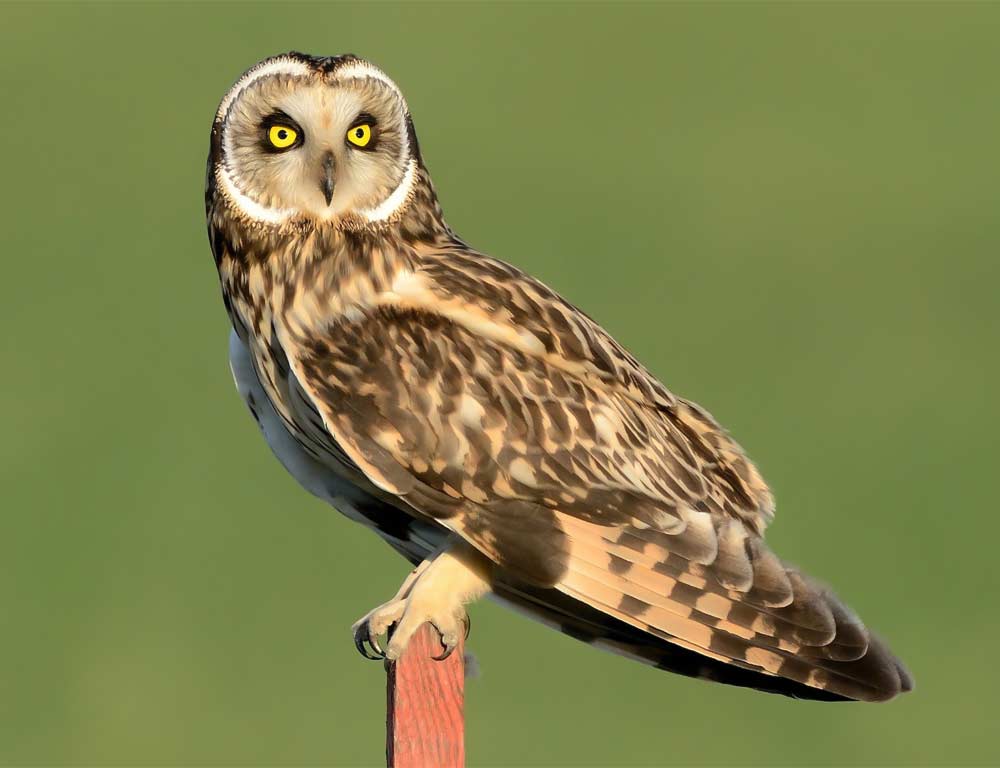
- Scientific Name: Asio flammeus
- Population: Irregular visitors, more common during winter
- Life Span: 3-5 years in the wild
- Size: 13-17 inches tall
- Weight: 7-16 ounces
- Wingspan: 33-43 inches
- Status: Least Concern
The Short-eared Owl, named for its short ear tufts that are often not visible, is a bird of open habitats such as grasslands and marshes.
While not permanent residents, these owls are more commonly observed in Minnesota during the winter months.
Short-eared Owls are diurnal hunters, often seen flying low over fields in search of small mammals. They are known for their buoyant, moth-like flight.
Conservation efforts aim to protect their wintering habitats and address potential threats during their irregular visits to the region.
10. Burrowing Owl
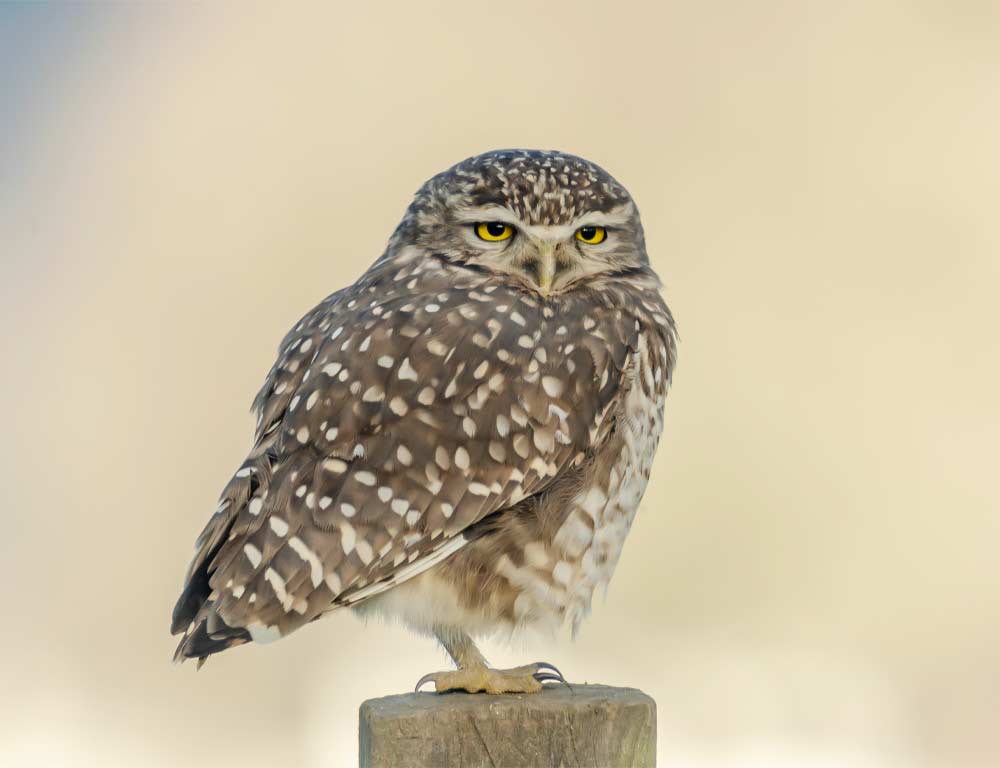
- Scientific Name: Athene cunicularia
- Population: Limited in Minnesota, mainly found in specific habitats
- Life Span: 6-8 years in the wild
- Size: 7-10 inches tall
- Weight: 4-8 ounces
- Wingspan: 21-24 inches
- Status: Declining in some areas
The Burrowing Owl is a unique species known for its ground-dwelling habits. While not as common in Minnesota, they are occasionally found in specific grassland habitats.
Burrowing Owls are diurnal hunters, relying on insects, small mammals, and occasionally birds for their diet.
True to their name, Burrowing Owls nest in burrows dug by mammals or abandoned prairie dog burrows. They are often observed perched near their burrows during the day.
In Minnesota, conservation efforts focus on preserving suitable grassland habitats, as agricultural development and habitat loss threaten these small owls.
11. Boreal Owl
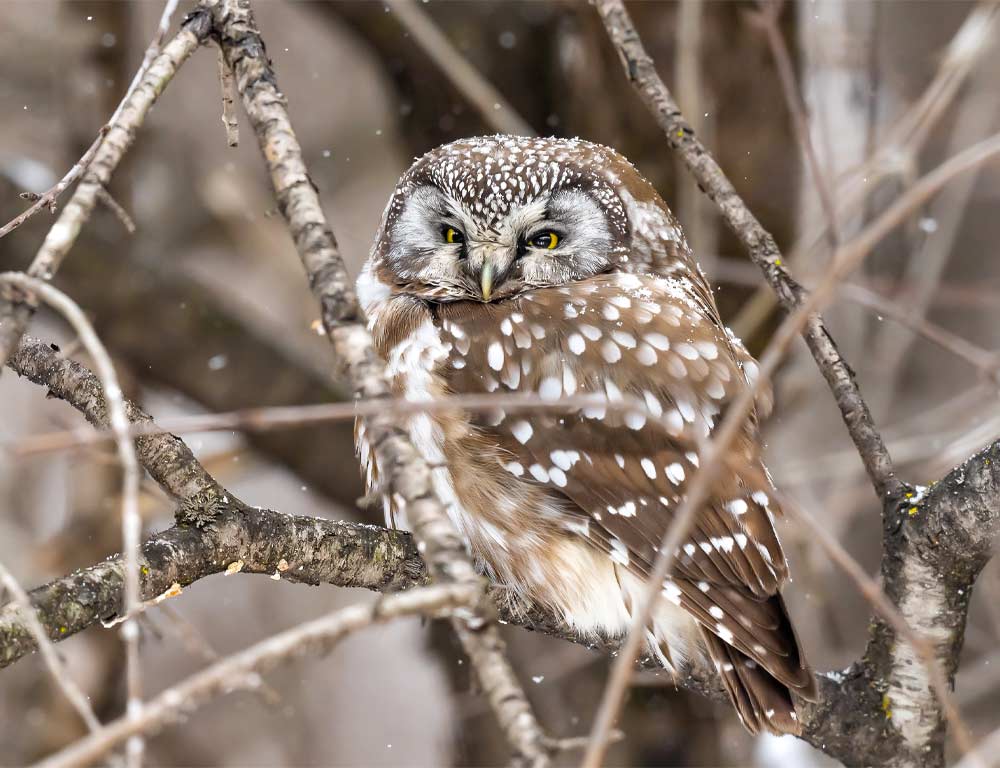
- Scientific Name: Aegolius funereus
- Population: Present in northern forests, but less common than some other owl species
- Life Span: 3-6 years in the wild
- Size: 8-12 inches tall
- Weight: 3-7 ounces
- Wingspan: 21-24 inches
- Status: Least Concern
The Boreal Owl, adapted to northern forested environments, is found in parts of Minnesota, particularly in coniferous and mixed woodlands.
These small, nocturnal hunters feed on small mammals and birds, using their excellent hearing to locate prey.
Boreal Owls often nest in tree cavities, and their population dynamics are closely tied to the abundance of their preferred prey.
In Minnesota, conservation efforts include monitoring their populations and ensuring the health of northern forest ecosystems, as they are vital in controlling rodent populations.
When And Where to Spot Owls in Minnesota?
Owls in Minnesota can be spotted in diverse habitats. Great Horned Owls favor woodlands, while Burrowing Owls are found in grasslands.
Boreal Owls inhabit northern forests, and Snowy Owls may grace open fields. Research each species’ preferred habitat for a targeted search.
Nocturnal Quests
Many owl species, like the Barred Owl and Eastern Screech Owl, are nocturnal. Plan your outings during dusk or dawn when they’re active.
Bring along a flashlight with a red filter to minimize disturbance, enhancing your chances of spotting these elusive creatures.
Seasonal Migrations
Keep an eye on seasonal patterns. Snowy Owls, for instance, are winter visitors. Great Grey Owls might migrate irregularly during “irruption” years.
Understanding these movements aids in planning your excursions to coincide with peak owl activity.
Nature Reserves and Parks
Minnesota boasts various nature reserves and parks, such as Sax-Zim Bog and Tamarac National Wildlife Refuge, which are known for owl sightings.
Consult local birding guides or online platforms to identify prime locations, increasing your likelihood of encountering these majestic birds.
Nesting Sites Observation
During the breeding season, owls are often tied to their nesting sites. Research nesting behaviors of specific species and monitor suitable locations, such as tree cavities, abandoned nests, or even artificial nest boxes.
Patience and vigilance near potential nesting sites may reward you with glimpses of owl parents and their fledglings.
Auditory Exploration
Owls communicate through distinctive calls. Educate yourself on the unique vocalizations of local owl species. Night excursions equipped with a field guide or birding app can help you identify owls by their calls.
Many owls respond to playback, making it a useful tool for attracting them for observation, though it should be used responsibly and sparingly.
Local Birding Communities
Connect with local birding communities or ornithological societies. These enthusiasts often share recent sightings, tips, and valuable information on where specific owl species have been observed.
Networking with experienced birders enhances your chances of a memorable owl encounter in Minnesota.
Wrapping Up
In the twilight realms of Minnesota, owls silently navigate diverse landscapes. From the iconic Great Horned Owl to the elusive Boreal Owl, our exploration unveils their fascinating lifestyles, habitats, and the vital conservation efforts to preserve these mystical creatures.
As nocturnal hunters, their unique adaptations contribute to the delicate balance of ecosystems, and understanding their roles fosters a deeper appreciation for the rich biodiversity of Minnesota.
The diverse owl species in Minnesota, from the ground-dwelling Burrowing Owl to the majestic Great Grey Owl, play integral roles in the state’s ecosystems.
From their nesting habits to hunting techniques, each owl species presents a unique narrative of survival and adaptation.
Conservation efforts are crucial to ensuring their continued presence in the region and maintaining the ecological equilibrium they contribute to. Thank you so much.